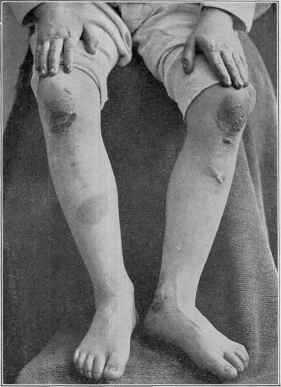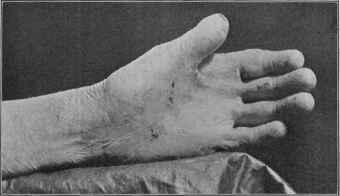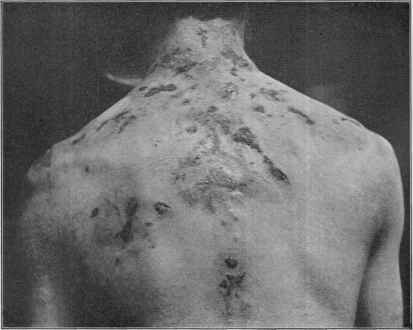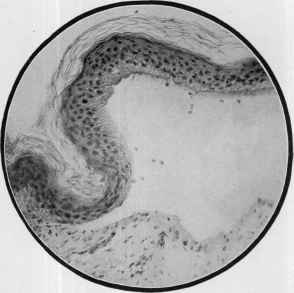| MEDICAL INTRO |
| BOOKS ON OLD MEDICAL TREATMENTS AND REMEDIES |
THE PRACTICAL |
ALCOHOL AND THE HUMAN BODY In fact alcohol was known to be a poison, and considered quite dangerous. Something modern medicine now agrees with. This was known circa 1907. A very impressive scientific book on the subject. |
DISEASES OF THE SKIN is a massive book on skin diseases from 1914. Don't be feint hearted though, it's loaded with photos that I found disturbing. |
EPIDERMOLYSIS BULLOSA
Synonyms.—Epidermolysis bullosa hereditaria; Acantholysis bullosa.
This is a rare affection, described (Goldschneider, Köbner, Blumer;
Valentine, Elliot, Hallopeau, Beatty, Bowen, and others) in recent
years, characterized by the formation of vesicles and blebs on any
part subjected to slight rubbing, knocks, or irritation. It is usually
hereditary,1 the same condition, as a rule, having existed in one or
1 Bettman, Dermatolog. Zeitschr., 1903, vol. x, p. 561, abstract in Brit. Jour. Derm.,
1904, p. 198, gives a striking example of hereditary transmission. His cases were a
father and two daughters, with this family history: First known case was a daughter (1
of 13 children); of her 10 children, 2 were affected; 1 of these affected was married,
and of her 14 children, 2 were affected; of these 1 (female) had 5 children, of whom 4
were affected; the other of the two (a male) had 2 children, both of whom were affected.
Valentin, Archiv, 1906, vol. lxxviii, p. 87, also records a somewhat similar instance of
heredity; also Engman and Mook, Jour. Cutan. Dis., 1906, p. 55 (in 1 of their 4 cases);
McMurray and L. Johnston, Australasian Med. Gaz., Jan. 25, 1913, p. 74—2 cases
father and son, beginning in both in the first year of life.
390
INFLAMMATIONS

Fig. 94.—Epidermolysis bullosa, showing blebs, mostly broken, on those parts
most subject to pressure and slight traumatism, as about the ankle, tibial surface,
knees, and dorsal surface of the fingers (courtesy of Dr. J. C. Johnston).

Fig. 95.—Epidermolysis bullosa, with atrophy of finger-ends and loss of nails,
and thinning of skin from constant vesicle and bleb formation—case referred to in the
text—upper part of back of same patient is shown in other cut.
more previous generations. It generally makes its first appearance in
early infancy or childhood, and the tendency persists indefinitely.
The lesions consist of small and large bullæ, exceptionally partly
EPIDERMOLYSIS BULLOS A
391
hemorrhagic, arising especially on parts of the surface subjected to
friction from the wearing apparel, collar, wristband, etc, as on various
parts of the body; or from slight knocks or pressure, as on the hands
from the use of implements, over the joints, etc They are also observed
in the mouth in some cases. The skin remains free if not subjected
to such influences. In some instances the susceptibility is less marked
than in others. As a rule, the blebs disappear without trace; excep
tionally some pigmentation and slight scarring result. In a case under
my observation the neck and upper back, wrists, and hands exhibited
almost continuous bleb-formation, the hand lesions resulting from
work (drawing and designing). This tendency was especially noted

Fig. 96.—Epidermolysis bullosa—blebs collapsed or rubbed off. Condition most
marked here, on knees and lower parts of legs, and forearms and hand—case referred
to in the text.
at the finger-ends, and finally led to some atrophy and nail-loss. The
patient is now thirty, and the condition has existed since birth, although
the tendency is gradually lessening. In some instances a similar
atrophy of the finger-ends, associated with alopecia (G. W. Wende and
others)1 has also been observed.
1 G. W. Wende (1 case), Jour. Cutan. Dis., 1902, p. 537 (with references and illus
trations), and (1 case), ibid., 1904, p. 14 (with illustration); Pernet, Brit. Jour. Derm.,
1904, p. 225 (nails, both of fingers and toes, were nonexistent); Colcott Fox, Brit.
Jour. Derm., 1905, p. 223 (case, with progressive deformations); Sichel, ibid., p. 307
(case presentation; with deformations and cicatricial alopecia); Savill, ibid., p. 460 (case
presentations; 2 brothers); Petrini-Galatz, Annales, 1906, p. 766 (2 cases, congenital
and dystrophic; histologic; with many references); Williams, Brit. Jour. Derm., Jan.,
1907, p. 10 (evidences of antenatal development); Allworthy, Brit. Jour. Derm., 1910,
P. 373 (with good illustrations; congenital; dystrophy of thumb and great toe-nails).
392 INFLAMMATIONS
The general health is not involved. In some cases there is an asso
ciation of milium-like cysts (Augagneur, Beatty, Bowen, Bukovsky).1
The nature of the disease is obscure. The mild traumatism, if it
can be so called, excites rapid exudation from the dermal vessels into
the rete, separating this latter, and giving rise to blebs. Elliot's investi
gations lead to the conclusion that epidermolysis bullosa is not
a disease in the strict sense of the term, but a cutaneous condition;
the individual is born with a congenital irritability of the vascular supply
of the skin, which responds to every irritation, and in consequence
the basal portion of the rete is kept bathed in a more or less serous
transudation, inducing degenerative changes; greater or repeated

Fig. 97.—Epidermolysis bullosa: section of a portion of a bulla, showing the degen
eration of the basic portion of the rete (courtesy of Dr. Geo. T. Elliot; photomicrograph
by Dr. J. A. Fordyce).
irritation causes greater exudation, detaching the loosely fastened
rete, and the bleb is thus formed. Engman and Mook2 found the
1 For complete clinical survey and résumé of the disease see Wallace Beatty‘s paper,
Brit. Jour. Derm., 1897, p. 301; Bowen's paper, Jour. Cutan. Dis., 1898, p. 254, and
for the histopathologic aspects, Elliot‘s paper, Trans. Amer. Derm. Assoc. for 1899; H.
L. Smith, Maryland Med. Jour., April, 1901, reports a case in a negro, with notes on
the blood and vesicle cells by T. R. Brown, who found both local and general eosino-
philia. This paper also gives a summary of the literature. Bukovsky‘s (Archiv, 1903,
vol. lxvii, p. 163) investigation of these bodies showed (as also demonstrated by others)
a histologic connection with the sweat-ducts—retentive cysts of the ducts, their outlets
becoming blocked by the healing of the bullæ. Engman and Mook's investigations
confirm this; their paper (loc. cit.) reviews the disease, and gives full bibliography.
2 Engman and Mook, 1906, loc. cit., and Trans. Amer. Derm. Assoc. for 1909, p. 151,
Jour. Cutan. Dis., 1910, p. 275, and Interstate Med. Jour., July, 1911, p. 499—constantly
found elastic tissue absent or practically so. Kanoky and Sutton‘s investigations,
Jour. Amer. Med. Assoc, April 2, 1910, p. 1137, confirm the Engman-Mook findings.
Review, summary and references will be found in these several papers.
DERMATITIS REPENS
393
elastic tissue almost completely absent, and attribute the disease to
this factor.
Treatment has no influence in modifying or lessening this tendency;
puncturing the lesions when small curtails their growth (Allworthy).
As much as possible pressure and friction should be guarded against;
soothing and protective applications should be made to the excoriated
surfaces.
But first, if you want to come back to this web site again, just add it to your bookmarks or favorites now! Then you'll find it easy!
Also, please consider sharing our helpful website with your online friends.
BELOW ARE OUR OTHER HEALTH WEB SITES: |
Copyright © 2000-present Donald Urquhart. All Rights Reserved. All universal rights reserved. Designated trademarks and brands are the property of their respective owners. Use of this Web site constitutes acceptance of our legal disclaimer. | Contact Us | Privacy Policy | About Us |